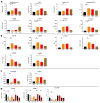Eicosanoid Profile of Influenza A Virus Infected Pigs
- PMID: 31277231
- PMCID: PMC6680658
- DOI: 10.3390/metabo9070130
Eicosanoid Profile of Influenza A Virus Infected Pigs
Abstract
Respiratory tract infections caused by the Influenza A virus (IAV) are a worldwide problem for human and animal health. Within this study, we analyzed the impact of IAV infection on the immune-related lipidome (eicosanoids) of the pig as new infection model. For this purpose, we performed HPLC-MS/MS using dynamic multiple reaction monitoring and analyzed lung, spleen, blood plasma and bronchoalveolar lavages. IAV infection leads to collective changes in the levels of the analyzed hydroxyeicosatrienoic acids (HETEs), hydroxydocosahexaenoic acids (HDHAs) and epoxyeicosatrienoic acids (EETs), and moreover, unique eicosanoid changes in several sample types, even under mild infection conditions. In accordance with different mouse infection studies, we observed infection-related patterns for 12-HETE, 15-HETE and 17-HDHA, which seem to be common for IAV infection. Using a long-term approach of 21 days we established an experimental setup that can be used also for bacterial-viral coinfection experiments.
Keywords: Influenza A virus; eicosanoids; infection; lipid mediator; pig.
Conflict of interest statement
The authors declare no conflict of interest.
Figures


Similar articles
-
Bioactive lipid screening during respiratory tract infections with bacterial and viral pathogens in mice.Metabolomics. 2022 Jun 10;18(6):39. doi: 10.1007/s11306-022-01898-4. Metabolomics. 2022. PMID: 35687250 Free PMC article.
-
Altered Respiratory Microbiomes, Plasma Metabolites, and Immune Responses in Influenza A Virus and Methicillin-Resistant Staphylococcus aureus Coinfection.Microbiol Spectr. 2023 Aug 17;11(4):e0524722. doi: 10.1128/spectrum.05247-22. Epub 2023 Jun 15. Microbiol Spectr. 2023. PMID: 37318361 Free PMC article.
-
Time-Dependent Proinflammatory Responses Shape Virus Interference during Coinfections of Influenza A Virus and Influenza D Virus.Viruses. 2022 Jan 24;14(2):224. doi: 10.3390/v14020224. Viruses. 2022. PMID: 35215819 Free PMC article.
-
Epoxyeicosatrienoic Acids and 20-Hydroxyeicosatetraenoic Acid on Endothelial and Vascular Function.Adv Pharmacol. 2016;77:105-41. doi: 10.1016/bs.apha.2016.04.003. Epub 2016 May 5. Adv Pharmacol. 2016. PMID: 27451096 Free PMC article. Review.
-
Secondary streptococcal infection following influenza.Microbiol Immunol. 2022 Jun;66(6):253-263. doi: 10.1111/1348-0421.12965. Epub 2022 May 26. Microbiol Immunol. 2022. PMID: 35088451 Review.
Cited by
-
Influenza A Virus Exacerbates Group A Streptococcus Infection and Thwarts Anti-Bacterial Inflammatory Responses in Murine Macrophages.Pathogens. 2022 Nov 10;11(11):1320. doi: 10.3390/pathogens11111320. Pathogens. 2022. PMID: 36365071 Free PMC article.
-
The Role of Lipid Metabolism in Influenza A Virus Infection.Pathogens. 2021 Mar 5;10(3):303. doi: 10.3390/pathogens10030303. Pathogens. 2021. PMID: 33807642 Free PMC article. Review.
-
Influenza A H1N1 Induced Disturbance of the Respiratory and Fecal Microbiome of German Landrace Pigs - a Multi-Omics Characterization.Microbiol Spectr. 2021 Oct 31;9(2):e0018221. doi: 10.1128/Spectrum.00182-21. Epub 2021 Oct 6. Microbiol Spectr. 2021. PMID: 34612695 Free PMC article.
-
16HBE Cell Lipid Mediator Responses to Mono and Co-Infections with Respiratory Pathogens.Metabolites. 2020 Mar 18;10(3):113. doi: 10.3390/metabo10030113. Metabolites. 2020. PMID: 32197522 Free PMC article.
-
Bioactive lipid screening during respiratory tract infections with bacterial and viral pathogens in mice.Metabolomics. 2022 Jun 10;18(6):39. doi: 10.1007/s11306-022-01898-4. Metabolomics. 2022. PMID: 35687250 Free PMC article.
References
-
- Rice T.W., Rubinson L., Uyeki T.M., Vaughn F.L., John B.B., Miller R.R., 3rd, Higgs E., Randolph A.G., Smoot B.E., Thompson B.T., et al. Critical illness from 2009 pandemic influenza a virus and bacterial coinfection in the united states. Crit. Care Med. 2012;40:1487–1498. doi: 10.1097/CCM.0b013e3182416f23. - DOI - PMC - PubMed
Grants and funding
LinkOut - more resources
Full Text Sources

